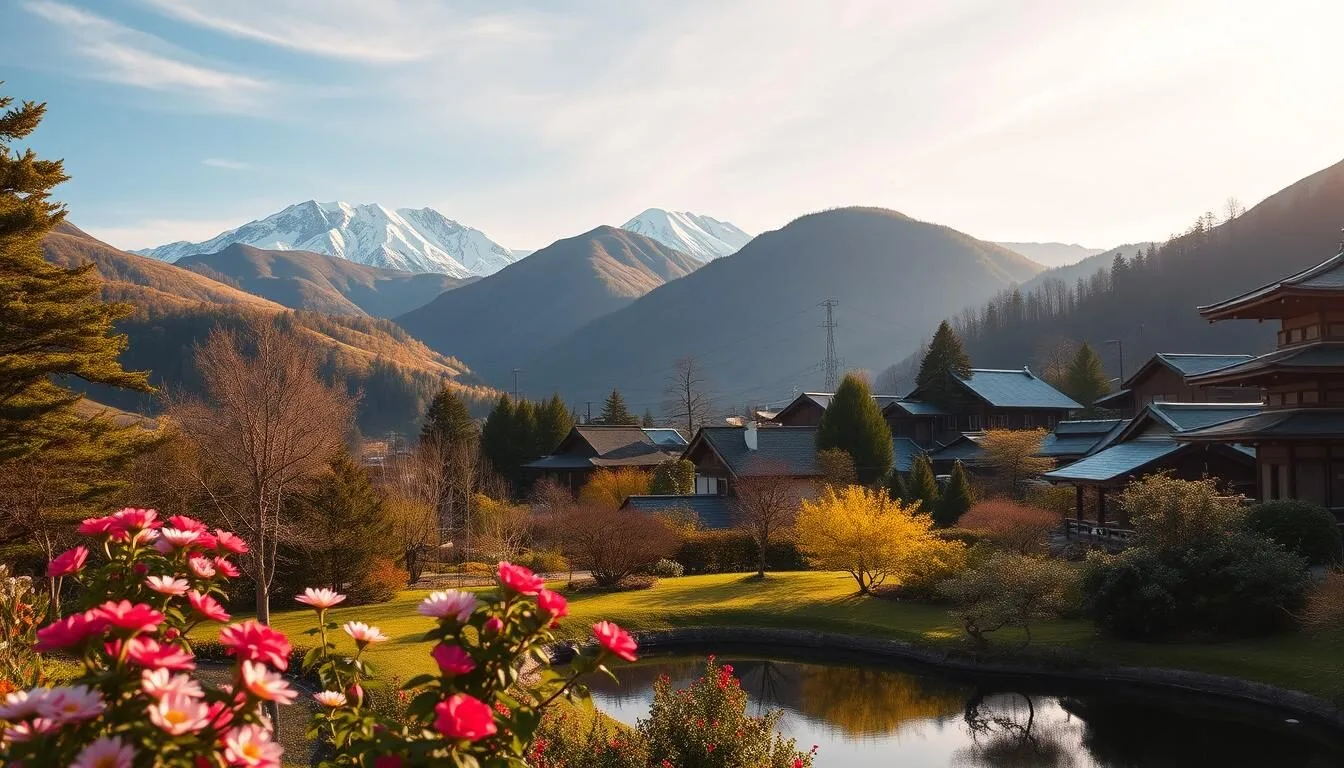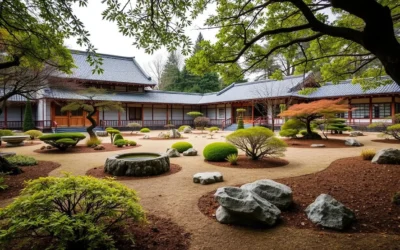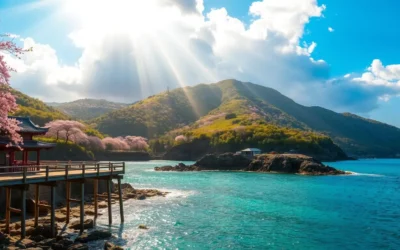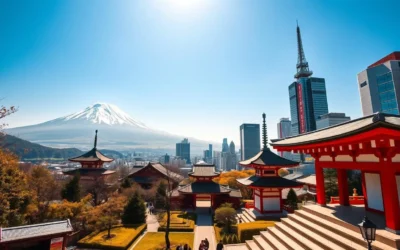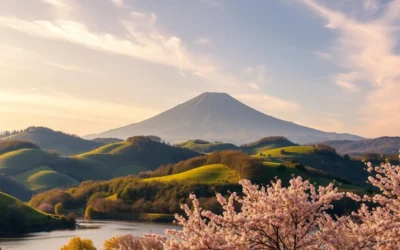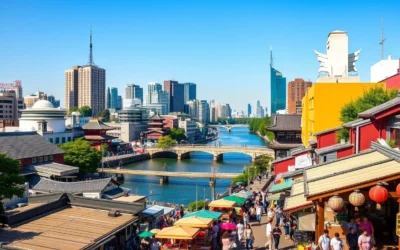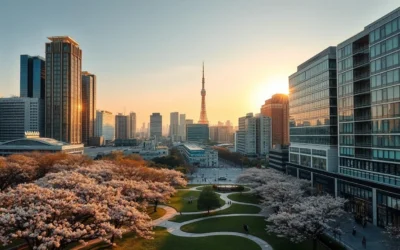Planning a trip to Niigata Prefecture requires understanding its unique seasonal patterns to maximize your travel experience. The region offers distinctly different attractions throughout the year, from world-class skiing in winter to lush rice terraces in summer.
To make the most of your trip, it’s essential to determine the ideal time to visit based on your weather preferences and desired activities. Understanding Niigata’s climate patterns will ensure you pack appropriately and enjoy comfortable travel conditions.
Whether you’re seeking cultural experiences, outdoor adventures, or culinary delights, timing your visit right is crucial for an optimal Niigata experience.
Discovering Niigata Prefecture: Japan’s Hidden Gem
With its stunning coastline and diverse geography, Niigata Prefecture is a destination that promises an unforgettable travel experience. Located on the west coast of Honshu, Japan’s largest island, Niigata is a treasure trove of natural beauty, rich history, and vibrant culture.
Geographic Location and Landscape
Niigata Prefecture is situated in a region where the Japanese Alps meet the Sea of Japan, creating a diverse landscape that ranges from coastal plains to mountainous areas. This varied geography not only offers breathtaking scenery but also influences the local climate and weather patterns, making it a fascinating place to explore at different times of the year.
Cultural Significance and History
Niigata has a rich cultural heritage, with a history that dates back centuries. The prefecture is home to numerous historical sites, including ancient temples and traditional villages. The local culture is also reflected in its festivals, crafts, and cuisine, offering visitors a unique travel experience that is deeply rooted in tradition.
| Cultural Aspect | Description | Seasonal Relevance |
|---|---|---|
| Traditional Festivals | Vibrant events showcasing local culture | Summer and Autumn |
| Local Cuisine | Fresh seafood and traditional dishes | Available throughout the year |
| Historical Sites | Ancient temples and ruins | Accessible year-round |
Why Weather Matters When Visiting Niigata
The weather in Niigata significantly impacts the travel experience, with distinct seasons offering different activities and landscapes. Understanding the local climate is crucial for planning your trip, as it affects not only the activities you can enjoy but also your comfort and safety during travel.
Niigata’s extreme seasonal variations mean that your experience will differ dramatically depending on when you visit. For instance, the prefecture is renowned for its skiing in the winter, particularly on the slopes of Myoko Kogen. In contrast, the warm June weather brings its hiking trails, hot springs, and stunning coastal scenery to life.
By considering the weather and season, you can tailor your visit to enjoy the best that Niigata has to offer, whether it’s winter sports, spring cherry blossoms, summer festivals, or autumn foliage.
Niigata’s Four Distinct Seasons: Climate Overview
As you explore Niigata, you’ll discover that its four distinct seasons bring a range of weather conditions that are both challenging and rewarding. The prefecture’s unique geography, with its coastline along the Sea of Japan and varied topography, creates diverse microclimates across different regions.
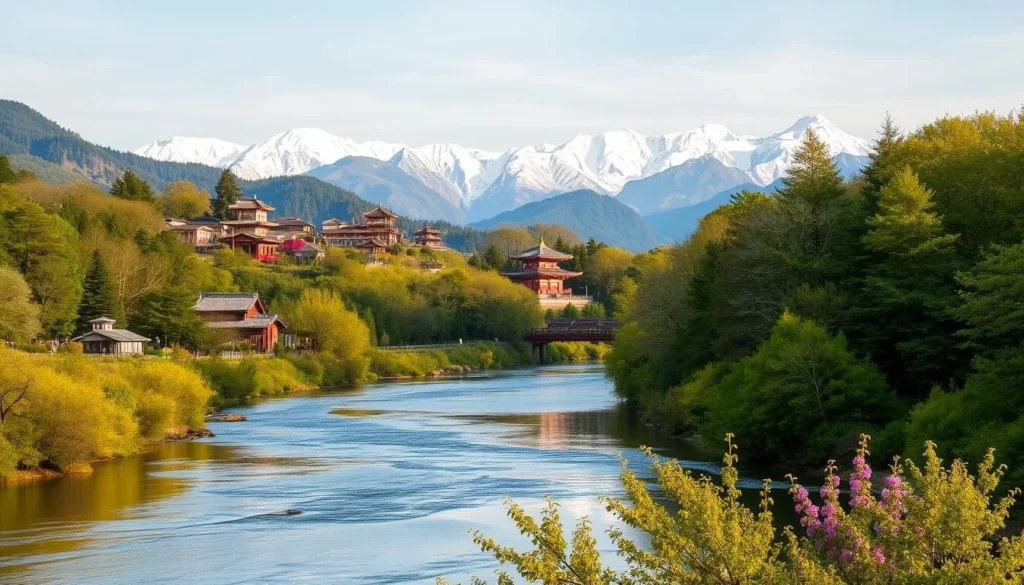
Temperature Patterns Throughout the Year
Niigata’s temperature varies significantly throughout the year. Winters are cold, with temperatures often below freezing, especially in the mountainous areas like Myoko Kogen, which is renowned for its skiing. In contrast, summers are warm but generally less humid than in other parts of Japan, making Niigata an attractive summer destination. Spring and autumn offer mild temperatures, ideal for outdoor activities and sightseeing.
Precipitation and Humidity Levels
Niigata is known for its heavy snowfall during winter, with some areas receiving over 10 feet of snow annually, earning it the nickname “yukiguni” or “snow country.” The weather patterns in Niigata are influenced by cold Siberian air masses, resulting in powder snow that’s perfect for skiing. Summers experience less precipitation than winters, but the humidity levels remain relatively high. Spring and autumn have more moderate precipitation levels, making them pleasant seasons to visit.
How Niigata’s Climate Differs from Other Japanese Regions
Niigata’s climate is distinct from other parts of Japan, particularly those facing the Pacific Ocean. Its location on the Sea of Japan coast exposes it to heavy snowfall and different precipitation patterns. Unlike major cities like Tokyo, Niigata experiences a more continental climate with colder winters and warmer summers. This unique climate makes Niigata a popular destination for those seeking a traditional Japanese winter experience or a cooler summer retreat. As a result, Niigata stands out as a significant region in the country for its climatic characteristics.
Overall, understanding Niigata’s climate is crucial for planning your trip and making the most of your visit. Whether you’re interested in skiing, cherry blossoms, or simply experiencing the local culture, Niigata’s distinct seasons offer something for everyone.
Spring in Niigata: Cherry Blossoms and Renewal (March-May)
Niigata’s spring season, spanning from March to May, offers a unique blend of natural beauty and cultural experiences. As the cold winter months subside, the region transforms into a vibrant landscape, attracting visitors from around the world.
Cherry Blossom Viewing Spots and Timing
Niigata tends to experience its cherry blossom (sakura) season later than the rest of Japan, often beginning in mid-April or even May due to its colder early-year temperatures. This delayed blooming period provides a unique opportunity for visitors to enjoy the blossoms without the crowds.
Some popular spots for cherry blossom viewing include parks and gardens along the Shinano River and in the city of Niigata. The cherry blossom forecast is typically released annually, helping travelers plan their trip to coincide with the peak blooming period.
Spring Festivals and Cultural Events
Spring in Niigata is not just about the cherry blossoms; it’s also a time for various cultural festivals and events. The region hosts numerous spring festivals, celebrating the arrival of warmer weather and the renewal of nature.
These events often feature traditional music, dance, and local cuisine, providing a rich cultural experience for visitors. For instance, the Niigata City’s spring festival typically includes parades, food stalls, and traditional performances.
Spring Weather Patterns and Appropriate Clothing
During the spring, temperatures in Niigata gradually warm from the 40s°F (5-10°C) in March to the 60s°F (15-20°C) in May. However, there is considerable variation between early and late spring, and visitors should be prepared for fluctuating temperatures throughout the day.
It’s advisable to pack layers, including light jackets, sweaters, and scarves, to adjust to the changing weather conditions. Additionally, spring showers are common, so carrying a compact umbrella or a light rain jacket is recommended.
Evening temperatures can drop significantly, making it essential to have an extra layer for nighttime activities, such as cherry blossom viewing or outdoor dining.
By understanding the time of year and being prepared for the weather, visitors can make the most of their spring trip to Niigata. With these tips, travelers can enjoy the region’s natural beauty and cultural events to the fullest.
Summer in Niigata: Coastal Beauty and Outdoor Adventures (June-August)
Summer in Niigata brings to life its stunning coastal scenery, hiking trails, and hot springs, making it an ideal time for outdoor enthusiasts to visit. The warm weather during these months offers a wide range of activities and experiences that cater to different interests.
Beach Destinations and Water Activities
Niigata’s coastline is dotted with beautiful beaches that are perfect for swimming, sunbathing, and various water sports. Some popular beach destinations include:
- Kakuda Beach
- Nakame Beach
- Yahiko Beach
These beaches offer not just relaxation but also opportunities for surfing, paddleboarding, and other water activities. The warm summer temperatures, typically ranging from 75°F to 85°F (24°C to 29°C), make the water activities even more enjoyable.
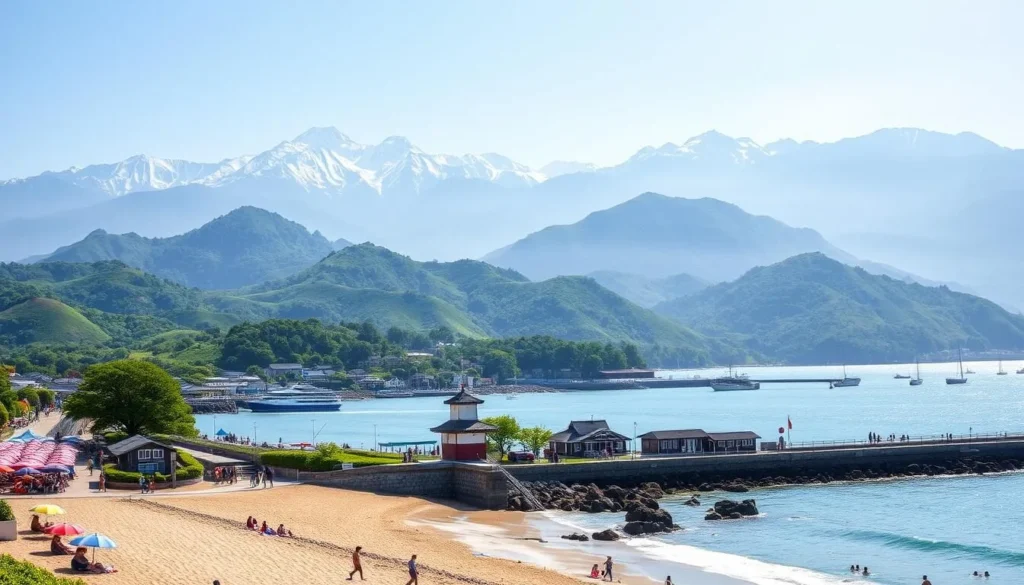
Hiking Trails and Mountain Escapes
For those who prefer land activities, Niigata’s mountains offer numerous hiking trails with breathtaking views. The warm June weather brings the trails to life, making it an excellent time for hiking and exploring the natural beauty of Niigata.
| Trail Name | Difficulty Level | Notable Features |
|---|---|---|
| Myoko Kogen Trail | Moderate | Panoramic views of the surrounding mountains |
| Nagaoka Kaifu Trail | Easy | Flowering plants and serene forest atmosphere |
Summer Weather Conditions and How to Stay Comfortable
While summer in Niigata can be hot and humid, especially in July and August, there are ways to stay comfortable. The coastal areas benefit from refreshing sea breezes that moderate the temperature and humidity. To enjoy your trip, consider the following tips:
- Wear lightweight, breathable clothing made from natural fibers.
- Use sun protection, including hats and sunscreen.
- Stay hydrated by carrying a refillable water bottle.
Additionally, be aware that Niigata experiences a rainy season, known as “tsuyu,” typically from mid-June to mid-July. This can bring periodic heavy rainfall, so it’s wise to plan your outdoor activities accordingly.
Fall in Niigata: Autumn Colors and Harvest Season (September-November)
Niigata’s autumn season, which spans from September to November, offers a unique blend of natural beauty, cultural experiences, and outdoor activities. As the summer heat dissipates, the prefecture transforms into a vibrant tapestry of autumn colors, making it an ideal time to explore its landscapes, participate in harvest festivals, and enjoy the comfortable fall weather.
Best Locations for Viewing Fall Foliage
Niigata is home to numerous scenic spots that are perfect for viewing the fall foliage. Some of the top locations include the hillsides and valleys surrounding the prefecture, where thick woodlands create breathtaking vistas of color. The cooler temperatures in areas like Myoko Kogen make them ideal for autumn visits.
For those looking to experience the best of Niigata’s autumn colors, consider visiting the following locations:
- Myoko Kogen
- Sado Island
- Tokamachi Rice Terraces
Harvest Festivals and Food Events
Fall in Niigata is not just about the beautiful autumn colors; it’s also a time for celebrating the harvest season. The prefecture hosts various festivals and food events that showcase local produce and traditional cuisine. Visitors can enjoy fresh seafood, sake, and other seasonal delicacies during these events.
Some of the notable harvest festivals and food events include:
| Event | Location | Date |
|---|---|---|
| Niigata Koshihikari Rice Festival | Uonuma City | Mid-October |
| Sado Island Seafood Festival | Sado City | Late September |
Fall Weather Patterns and What to Pack
During the fall season, Niigata’s weather gradually cools down, with temperatures ranging from the 70s°F (20-25°C) in September to the 50s°F (10-15°C) in November. It’s essential to pack layers for your trip, including light jackets and sweaters that can be added or removed as needed.
Some tips for packing for fall in Niigata:
- Bring layers for fluctuating temperatures
- Include a warm layer for cooler evenings
- Prepare for occasional rain showers
By understanding the fall weather patterns and being prepared, you can make the most of your trip to Niigata during the autumn season.
Niigata Prefecture, Japan: Best Months for a Weather-Savvy Trip
The best time to visit Niigata Prefecture depends on your preferences and what you want to experience. Niigata’s climate varies significantly throughout the year, offering a range of activities and landscapes that cater to different types of travelers.
March-May: Ideal for Cherry Blossoms and Mild Weather
Spring is a beautiful time in Niigata, with mild temperatures and the breathtaking sight of cherry blossoms. Late March to early April is particularly popular for hanami (cherry blossom viewing), with many parks and gardens offering stunning views. The weather during this period is generally pleasant, making it ideal for outdoor activities such as hiking and sightseeing.
As spring progresses into May, the weather becomes even more comfortable, with warmer temperatures and fewer rainy days. This makes it an excellent time for outdoor enthusiasts to explore Niigata’s natural beauty, including its hiking trails and scenic coastal areas.
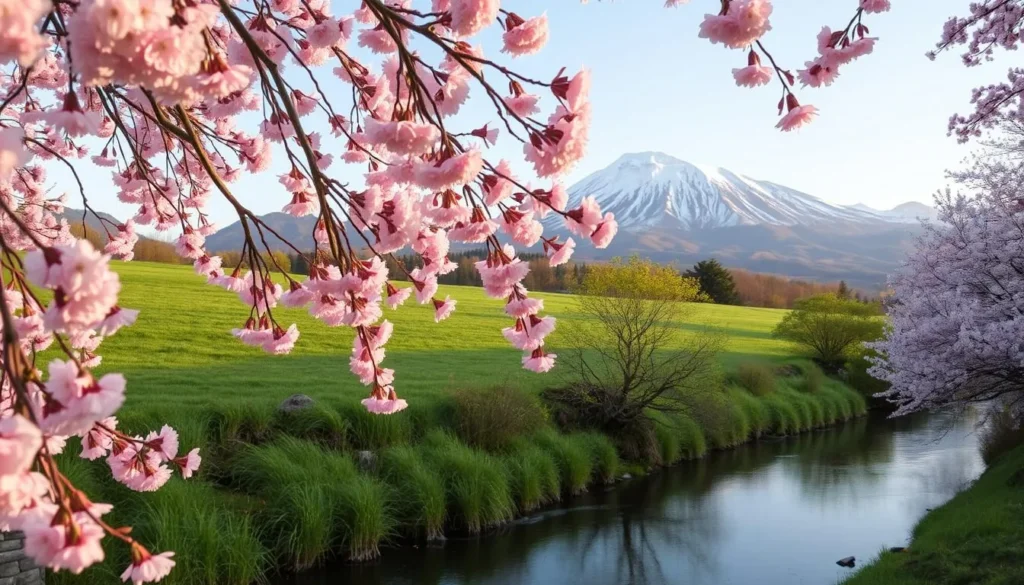
September-November: Perfect for Fall Colors and Comfortable Temperatures
Autumn in Niigata is another season of beauty, with the fall foliage attracting many visitors. September to November offers comfortable temperatures, making it perfect for enjoying the outdoors. The fall colors in Niigata are renowned, with the changing leaves creating a picturesque landscape.
During this period, the weather is generally mild, with a decrease in humidity compared to the summer months. This makes it an ideal time for cultural travelers to visit temples, museums, and traditional villages without the discomfort of extreme weather conditions.
Weather Considerations for Different Traveler Types
Different types of travelers have different preferences when it comes to weather. For instance, outdoor enthusiasts may prefer the mild temperatures of spring (May) or autumn (September-October) for hiking and nature exploration. Winter sports enthusiasts will find Niigata’s ski resorts, such as Myoko Kogen and Naeba, ideal during the winter months (December to February).
- Outdoor enthusiasts: Late spring (May) or early fall (September-October) for hiking and nature exploration.
- Winter sports enthusiasts: December through February for experiencing Niigata’s legendary powder snow.
- Cultural travelers: April-May or October-November for comfortable weather conditions.
- Photographers: Late April for cherry blossoms, June for green rice terraces, or late October for fall foliage.
- Travelers sensitive to heat and humidity: Avoid July and August.
By considering these factors, you can plan your trip to Niigata Prefecture at the most suitable time for your experience and activities, ensuring a memorable trip.
Exploring Niigata’s Natural Wonders: Seasonal Guide
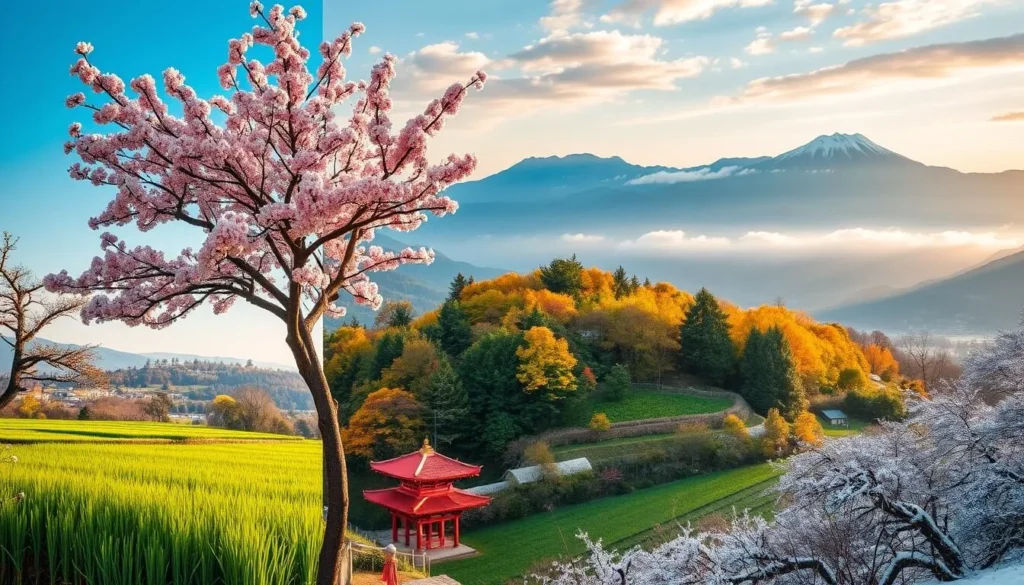
Niigata Prefecture is a treasure trove of natural beauty, with each season bringing its unique charm to the forefront. As you explore this region, you’ll encounter a variety of natural wonders that are sure to captivate your senses.
Echigo Tsumari Art Field: Best Visiting Times
The Echigo Tsumari Art Field is a unique cultural and natural attraction that transforms with the seasons. While it’s open year-round, the best time to visit depends on your preferences. Spring brings new life to the art installations, while autumn foliage provides a stunning backdrop.
In the spring, the art field comes alive with the renewal of nature, making it an ideal time for those who appreciate art amidst blooming flora. Autumn, on the other hand, offers a kaleidoscope of colors as the leaves change, creating a picturesque setting for the art installations.
Sado Island: Seasonal Attractions
Sado Island is another natural gem in Niigata, offering a range of seasonal attractions. Summer is a great time to enjoy the island’s beautiful beaches and outdoor activities. In contrast, winter brings a serene quietness, ideal for those seeking a peaceful retreat.
The island’s diverse landscapes and activities make it a versatile destination, suitable for various interests and preferences throughout the year.
Tokamachi Rice Terraces: When to Visit
Tokamachi’s rice terraces are renowned for their breathtaking beauty, which changes dramatically throughout the year. You can experience five distinct viewing experiences, each showcasing a different aspect of their beauty.
-
Early June is particularly magical when the newly planted rice paddies are filled with water, creating mirror-like reflections of the surrounding mountains and sky.
- Mid-summer (July-August) brings lush green growth that carpets the terraced hillsides.
- September and early October showcase golden-yellow mature rice plants ready for harvest.
- Winter occasionally transforms the terraces into a series of snow-covered geometric patterns.
The best time to visit depends on what you want to see, but early June is highly recommended for its unique reflections and serene atmosphere.
Cultural Experiences in Niigata Throughout the Year
Travelers to Niigata can enjoy a wide range of cultural experiences, from seasonal festivals to hands-on workshops. The region’s rich cultural heritage is reflected in its diverse activities and events, making it an ideal destination for those seeking an immersive experience.
Traditional Festivals by Season
Niigata hosts various traditional festivals throughout the year, each offering a unique glimpse into the region’s cultural practices. In the spring, the cherry blossom festivals attract large crowds, while summer brings vibrant summer festivals. Autumn is marked by harvest festivals, and winter is characterized by snow festivals, each with its own distinct charm.
For instance, the Niigata Gion Festival in July features traditional dances and performances, showcasing the region’s cultural heritage. Similarly, the Tokamachi Snow Festival in February is a must-visit for those who enjoy winter festivities.
| Season | Festival | Description |
|---|---|---|
| Spring | Cherry Blossom Festival | Celebration of cherry blossoms with food stalls and traditional performances. |
| Summer | Niigata Gion Festival | Traditional dances and performances. |
| Autumn | Harvest Festival | Celebration of the harvest season with local food and drinks. |
| Winter | Tokamachi Snow Festival | Festival featuring snow sculptures and illuminations. |
Sake Brewing Tours and Tastings
Niigata is renowned for its sake, and visitors can explore this aspect of the region’s culture through sake brewing tours and tastings. Many local breweries offer guided tours, providing insight into the sake-making process and the opportunity to sample some of the finest varieties.
Some notable sake breweries in Niigata include Koshinonokan and Niigata Sake Brewery, both offering tours and tastings that are sure to delight travelers interested in local cuisine.
Cultural Workshops and Activities
Niigata offers numerous hands-on cultural workshops that allow travelers to engage with traditional crafts and practices throughout the year. Participants can enjoy activities such as Shirone kite making, Tsubame-Sanjo metalworking, or Ojiya-chijimi textile weaving.
The Echigo-Tsumari Art Field is another cultural highlight, hosting various art workshops and participatory projects that connect visitors with local communities and contemporary artists. Seasonal activities like rice planting in spring, harvesting in fall, or snow crafts in winter offer authentic experiences that connect travelers with the region’s agricultural rhythms.
By engaging in these cultural activities, visitors can gain a deeper understanding of Niigata’s heritage and create lasting memories of their trip.
Niigata’s Hot Springs: Seasonal Soaking Guide
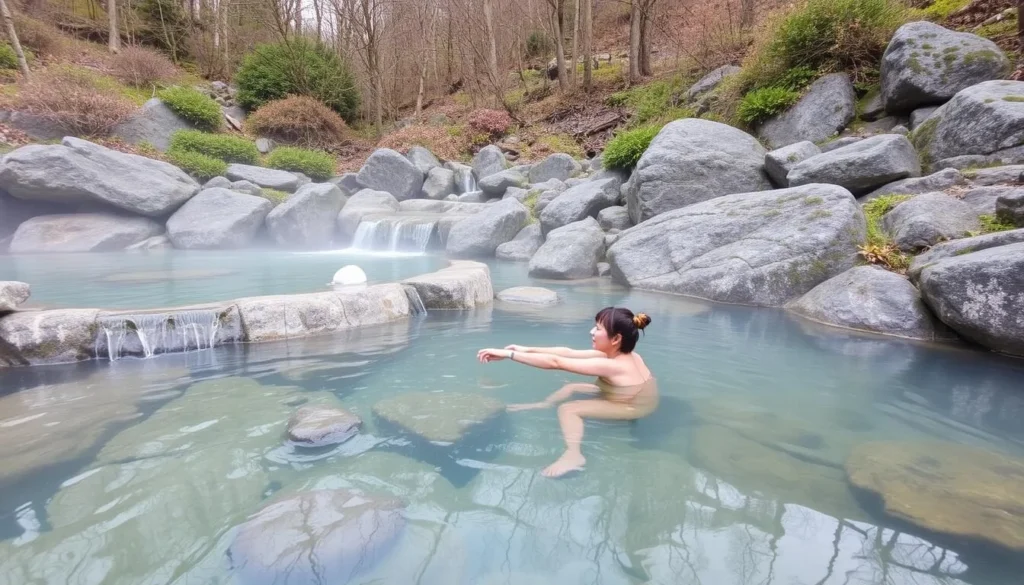
Immerse yourself in Niigata’s natural hot springs, a haven for those seeking tranquility. Niigata Prefecture is a treasure trove of hot spring experiences, with numerous hot springs scattered throughout the region. The prefecture’s unique geography, with its volcanic mountains and rich natural resources, makes it an ideal area for hot spring enthusiasts.
Winter Onsen Experience: Snow-Viewing Baths
In the winter, Niigata’s hot springs take on a magical quality. Soak in a snow-viewing bath, surrounded by serene landscapes, and let the stresses of everyday life melt away. Myoko Onsen offers multiple hot spring villages nestled at the base of volcanic mountains, with waters renowned for their mineral content and therapeutic properties.
Summer Hot Springs: Cooling Off Paradoxically
Even in the summer, Niigata’s hot springs are a great way to unwind. The hot springs in Echigo-Yuzawa provide a convenient getaway, with numerous facilities ranging from luxury resorts to public bathhouses. Visitors can enjoy the hot springs while taking in the stunning summer scenery.
Top Hot Spring Destinations in Niigata
Niigata is home to many exceptional hot spring destinations. Some of the top places include:
- Matsunoyama Onsen: One of Japan’s three famous medicinal hot springs, known for its dark brown, oil-rich waters.
- Sekikawa Village’s Shitada Onsen: Offers a secluded experience with riverside baths that change character with each season.
- Iwamuro Onsen: One of the prefecture’s oldest hot spring areas, dating back to the 16th century, perfect for travelers seeking authentic experiences.
Whether you’re looking to relax or rejuvenate, Niigata’s hot springs have something to offer every kind of traveler.
Culinary Journeys Through Niigata’s Seasons
Niigata’s culinary scene is a journey through the seasons, with each time of year bringing its own unique flavors and specialties. As you explore the region, you’ll discover a rich gastronomic culture that is deeply connected to the changing seasons and the prefecture’s natural resources.
Winter Delicacies: Seafood and Hearty Dishes
During the winter months, Niigata’s cuisine is characterized by hearty dishes and fresh seafood. The cold waters bring an abundance of seafood, including oysters and crab, which are often served raw or in hot pots. Winter is also a great time to enjoy nabe (Japanese hot pot), a comforting and nourishing meal that’s perfect for the cold season.
| Winter Dish | Main Ingredients | Description |
|---|---|---|
| Oyster Hot Pot | Oysters, Vegetables, Broth | A hearty and flavorful dish featuring fresh oysters from Niigata’s coast. |
| Crab Sushi | Crab, Sushi Rice, Nori | Fresh crab served as sushi, showcasing Niigata’s seafood. |
Spring and Summer Specialties
As spring arrives, Niigata’s cuisine shifts to incorporate fresh, seasonal ingredients. Spring vegetables and fresh fish become staples, with dishes like tempura and sashimi highlighting the region’s produce. Summer brings its own specialties, including grilled fish and cold noodles, perfect for the warmer weather.
- Spring vegetables like bamboo shoots and baby corn feature in various dishes.
- Fresh fish is often served as sashimi or grilled.
Fall Harvest: Rice, Sake, and Seasonal Ingredients
Fall is a significant season for Niigata’s cuisine, marking the harvest of the prefecture’s world-renowned rice. You can experience “shinmai” (new rice) during this season, with its distinctive sweet aroma and perfect texture. Autumn also brings a variety of mushrooms, including maitake, shiitake, and nameko, which are featured in seasonal dishes. The region’s chefs create special fall menus incorporating chestnuts, persimmons, and other seasonal ingredients.
Fall is also an excellent time to visit sake breweries, as they begin their new production cycle. You can learn about the connection between Niigata’s famous rice and its equally renowned sake, making for a unique culinary experience.
Accommodation Options for Different Seasons
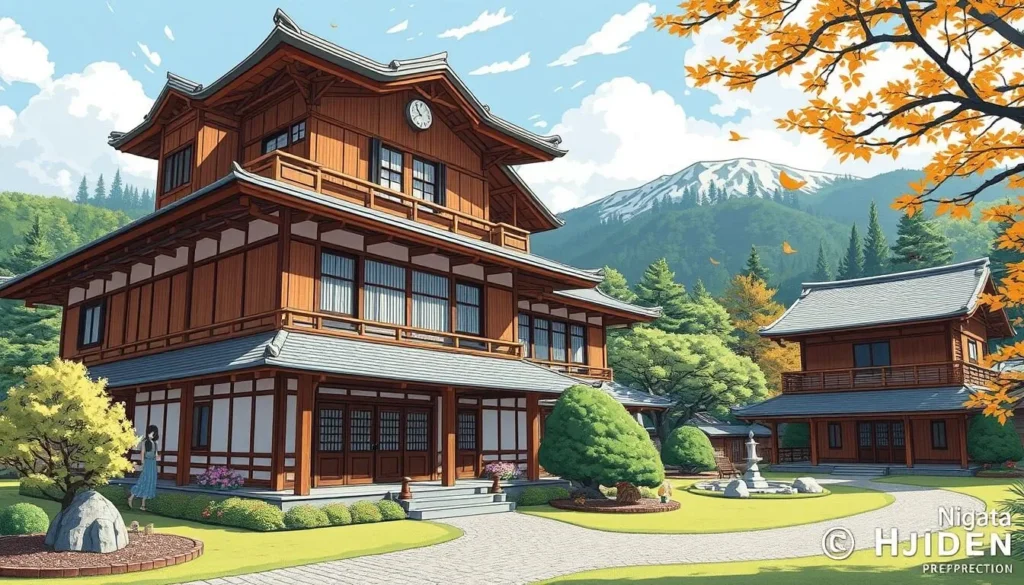
Experience the best of Niigata with accommodation choices that reflect the prefecture’s seasonal charm. Whether you’re looking for a relaxing retreat or an adventurous getaway, Niigata’s diverse hotels and ryokans cater to all types of travelers.
Winter Resort Stays
In the winter, Niigata transforms into a snow lover’s paradise, with resorts offering world-class skiing and snowboarding. Many of these resorts are accompanied by hotels that provide comfortable accommodations and amenities tailored to winter sports enthusiasts.
Coastal Accommodations for Summer
As summer arrives, Niigata’s coastline becomes a haven for those seeking beach activities and water sports. Coastal hotels offer the perfect blend of comfort and accessibility to the region’s beautiful beaches.
Traditional Ryokans for Authentic Experiences
For a truly authentic traditional Japanese experience, consider staying at one of Niigata’s many ryokans. These establishments offer a unique blend of cultural immersion, including experience with traditional Japanese customs, local cuisine, and relaxing hot spring baths.
Niigata’s ryokans are available year-round, with seasonal changes in decor, cuisine, and activities that enhance your stay. You’ll find historic properties in hot spring areas like Matsunoyama and Iwamuro, where centuries-old buildings have been preserved while offering modern comforts. Many ryokans feature private or semi-private hot spring baths, allowing guests to enjoy thermal waters in different seasons. Seasonal kaiseki meals showcase the prefecture’s culinary heritage, with ingredients and presentation changing to reflect each season’s distinctive offerings.
For travelers seeking cultural immersion, ryokans provide opportunities to experience traditional Japanese customs, including sleeping on futons, wearing yukata, and observing proper bathing etiquette. Visiting Niigata’s city areas, you’ll also find modern hotels that cater to a wide range of preferences and budgets.
Transportation Tips by Season
As you plan your trip to Niigata, understanding the transportation landscape is crucial for a smooth journey. Niigata’s transportation network is designed to adapt to its seasonal changes, ensuring that you can enjoy the prefecture’s beauty year-round.
Winter Travel Considerations
During the winter months, road conditions can become challenging due to snow and ice. It’s advisable to use public transportation when possible. Trains and buses are reliable options, but be sure to allow extra time for travel between destinations. Some rural areas may have limited services, so planning ahead is essential.
Tip: Consider purchasing a Niigata Wide Area Pass for unlimited travel on JR trains, buses, and some private railways, making it easier to explore the area without worrying about individual fares.
Getting Around During Peak Tourist Seasons
Peak tourist seasons, such as during cherry blossom viewing in spring and autumn foliage, attract large crowds. Trains and buses can be very busy, and popular routes may require advance reservations. Planning your itinerary with some flexibility can help you navigate these busy periods more comfortably.
Using local buses to tourist destinations can be an efficient way to get around, but be prepared for crowds. Booking accommodations near major transportation hubs can simplify your travel plans.
Off-Season Transportation Benefits
Traveling during Niigata’s off-seasons (late May-June and November) offers several transportation advantages. You’ll find that trains and buses are less crowded, making for a more comfortable journey. Without the peak season rush, you can enjoy a more relaxed pace.
- Less crowded trains and buses allow for more spontaneous travel planning.
- Rental cars become a more practical option during off-peak periods, offering better availability and the freedom to explore remote areas.
- Local buses operate with fewer passengers, reducing wait times.
- Transportation costs may decrease, with special discount passes and promotional fares available.
By understanding these seasonal variations in transportation, you can better plan your trip to Niigata, ensuring a enjoyable and stress-free travel experience.
Planning Your Itinerary: Sample Seasonal Plans
To make the most of your trip to Niigata, consider crafting an itinerary that incorporates the best of what each season has to offer. Niigata Prefecture is a destination that transforms with the seasons, providing a unique experience depending on when you visit.
As you plan your way through Niigata, you can choose from a variety of seasonal activities and attractions. Whether you’re looking for a quick getaway or an extended vacation, Niigata has something to offer.
3-Day Winter Adventure
A 3-day winter adventure in Niigata is perfect for those who love snow sports. Start your journey in Niigata City, exploring the local winter festivities and enjoying the city’s culinary delights. Then, head to Myoko Kogen for world-class skiing and snowboarding. Finish your trip with a visit to Matsunoyama Onsen, where you can relax in hot springs while viewing the snow-covered landscapes.
5-Day Spring Cherry Blossom Tour
Spring in Niigata is a beautiful time, with the cherry blossoms blooming across the prefecture. A 5-day tour could begin in Niigata City, where you can enjoy the blossoms at local parks and gardens. Then, travel to Sado Island, where the cherry blossoms and spring festivals await. The tour continues with visits to rural areas, enjoying the fresh spring produce and scenic landscapes.
Week-Long Summer and Fall Explorations
For a week-long exploration, consider visiting in summer or fall. In the summer, start with two days in Niigata City, exploring the Northern Culture Museum and Bandai Island. Then, take a ferry to Sado Island for three days of beaches, hiking, and cultural experiences. Finish with two days in the mountains at Matsunoyama Onsen to escape the heat.
In the fall, begin with two days exploring the Echigo-Tsumari Art Field, surrounded by autumn colors. Spend the next two days in the Tokamachi area, viewing the golden rice terraces before harvest. The final three days can be spent touring sake breweries and enjoying fall food festivals across the prefecture.
Both itineraries offer a balance of urban exploration and natural beauty, with cultural experiences that highlight the best of Niigata’s seasons. Consider using a rental car for part of your journey, especially in fall when the scenic drives are particularly rewarding.
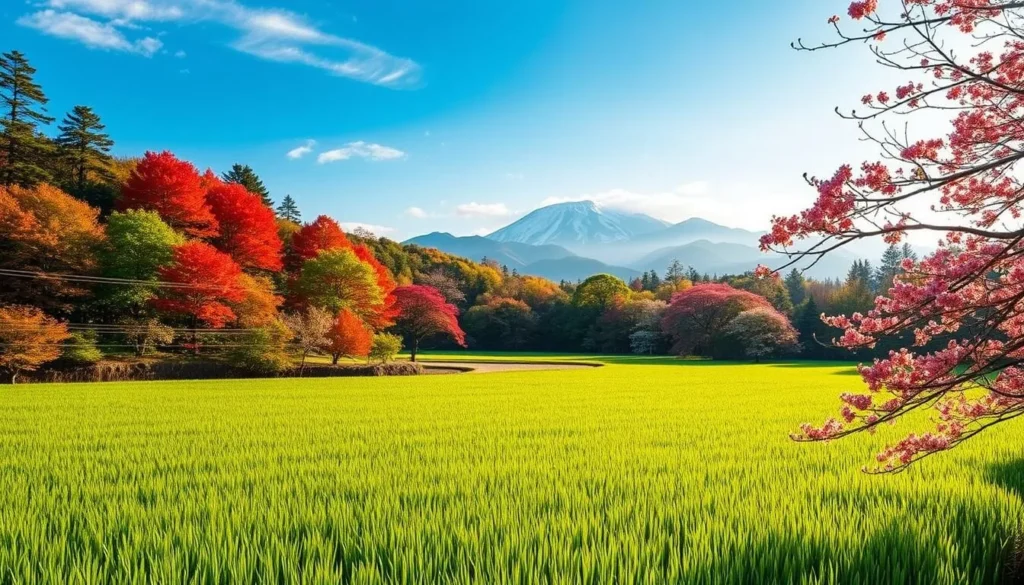
Weather-Related Travel Tips for Niigata
Preparing for Niigata’s weather is a key aspect of planning a successful and stress-free trip to this Japanese prefecture. Understanding the local climate and being prepared for its variations can significantly enhance your travel experience.
Packing Essentials for Each Season
Niigata’s distinct seasons require careful packing to ensure you’re prepared for the local weather conditions. In winter, pack warm clothing, including a heavy coat, gloves, and hats, as temperatures can drop significantly. Spring and autumn require layers, as temperatures can fluctuate. Summer is warm and humid, so light, breathable clothing is recommended.
Key items to pack:
- Winter: Thermal underwear, snow boots, and warm socks
- Spring: Light jacket, umbrella, and comfortable shoes
- Summer: Lightweight clothing, sunscreen, and a hat
- Autumn: Layers, waterproof jacket, and comfortable walking shoes
Weather Apps and Resources for Travelers
Staying informed about the weather is crucial for tourists visiting Niigata. Several weather apps and resources can help you navigate the local climate. The Japan Meteorological Agency website provides detailed forecasts, while apps like WeatherNews and The Weather Channel offer real-time updates.
| Resource | Description | Usefulness for Travelers |
|---|---|---|
| Japan Meteorological Agency | Official weather forecasts and warnings | High |
| WeatherNews | Real-time weather updates and forecasts | High |
| The Weather Channel | Global weather forecasts and radar imagery | Medium |
Emergency Preparedness for Seasonal Weather Events
Niigata can experience severe weather events, such as heavy snowfall in winter and typhoons in summer. Being prepared is key to staying safe. Familiarize yourself with the Japanese weather warning system, and consider purchasing travel insurance that covers weather-related disruptions.
By understanding Niigata’s weather patterns and being prepared, you can enjoy a smooth and enjoyable travel experience in this beautiful Japanese prefecture.
Conclusion
Whether you’re a foodie, an adventure seeker, or a culture enthusiast, Niigata has a lot to offer throughout the year. The prefecture’s diverse attractions make it an ideal destination for various types of travelers. From world-class skiing in the winter to vibrant festivals in the summer, Niigata’s seasonal experiences are as varied as they are unforgettable.
For most travelers, the best times to visit Niigata are late April to early May for cherry blossoms and comfortable temperatures, or mid-October to early November for autumn colors and harvest celebrations. However, the ideal month for your visit largely depends on your interests, whether you’re seeking cultural immersion, outdoor adventures, culinary experiences, or artistic exploration.
Niigata’s climate varies dramatically from heavy snow in winter to warm, occasionally humid conditions in summer. Thus, weather considerations should play a significant role in your planning. The prefecture’s transportation infrastructure accommodates year-round tourism, though winter travelers should allow extra time and flexibility for potential weather-related delays.
One of the advantages of visiting Niigata is its relative lack of international tourists compared to destinations like Tokyo and Kyoto, offering a more authentic experience of Japanese culture regardless of when you visit. You can consider combining your Niigata trip with visits to neighboring prefectures, timing your journey to experience different seasonal highlights across regions.
In conclusion, Niigata rewards weather-savvy travelers with unforgettable experiences in every season. Whether you’re drawn by powder snow, cherry blossoms, summer festivals, autumn colors, or year-round hot springs, Niigata has something special to offer. With its rich cultural heritage, stunning natural beauty, and diverse activities, Niigata Prefecture is a great destination for travelers looking to explore a less crowded but equally captivating side of Japan.
The above is subject to change.
Check back often to TRAVEL.COM for the latest travel tips and deals.
Here are some Tours & Sightseeing suggestions that might pique your interests!
